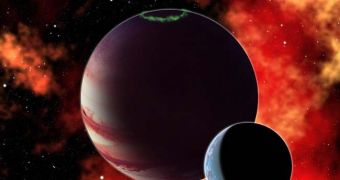Moons orbiting extrasolar planets may very well hold life, astronomers believe. That is why they are currently expanding their search for extraterrestrial intelligence to include exomoons, given that these celestial bodies are located at the right distance from their parent planets and their stars.
Exomoons have been proposed as a potential location for life to thrive for quite some time now. The entire premise of the blockbuster Avatar was that Pandora, a moon circling a gas giant, is habitable.
Such a scenario could come true in our own solar system, after the Sun exceeds its main sequence, turns into a red giant, and then collapses into a white dwarf. When this happens, the gas giants could make their way closer to the star.
The Jovian moon Europa and the Saturnine moons Enceladus and Titan could then go through changes that would make them habitable for life as we know it. Who is to say that the same thing has not yet happened in other solar systems as well?
The Hunt for Exomoons group is dedicated to finding such potential locations. These experts are a part of the science team interpreting the data sent back by the NASA Kepler Telescope. This observatory was developed specifically for finding Earth-like worlds around distant stars.
Back in February 2010, the dataset Kepler produced featured 37 Neptune-class and 10 Jupiter-class exoplanetary candidates that were located in their star's habitable zone. Obviously, liquid water cannot exist on gas giants, but the same is not true for their moons, Space reports.
Harvard-Smithsonian Center for Astrophysics (CfA) astronomer David Kipping, a member of the Kepler team, says that moons located around these worlds would tick “all the boxes for our wish list of habitable conditions.”
The expert selected a computer model that allows researchers to tease out the light signature of exomoons orbiting exoplanets that pass in front of their parent stars, in Kepler's field of view.
One thing experts need to be on the lookout for is not confusing exomoons with sunspots. At such great distances as Kepler is from its targets, that could very easily happen. “A starspot could look very similar,” Kipping explains.
Several research teams are currently developing their own models of teasing out exomoons in orbit around distant planets. “Everyone is finding their own approach to solving the problem, and I think they're really very complementary,” the CfA astronomer concludes.

 14 DAY TRIAL //
14 DAY TRIAL //